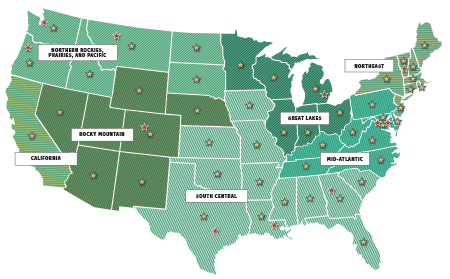Nothing is more important to wildlife than abundant and clean water. When rivers, wetlands, lakes, and shorelines are healthy, wildlife thrives. The U.S. Army Corps of Engineers plays the biggest role in managing these water resources. The Corps is responsible for thousands of water projects across the nation, including building dams, managing river levels, building levees for river barges and flood protection, and restoring ecosystems.
The National Wildlife Federation coordinates the Water Protection Network to ensure that water projects and polices are wildlife friendly, plus cost effective and environmentally safe.
The U.S. Army Corps of Engineers has three primary missions: improving navigation, flood control, and ecosystem restoration. But these missions sometimes come into conflict. For example, the Corps often uses river training structures, such as dykes and jetties, to facilitate navigation—yet these structures increase flood heights, damaging both homes and wildlife habitat.
The proposed St. John’s New Madrid Levee Project—which has the largest impact on wetlands of any current federal project—would impact 50,000 acres of important wetlands with devastating consequences to fish and wildlife resources, and exposing communities to greater flood risk.
During the past hundred years, structural Corps projects have wreaked havoc on the nation’s fish and wildlife resources while flood damages have increased at an alarming rate, despite construction of many federal flood damage reduction projects.
Louisiana Black Bear: Threatened Louisiana black bears live in wetlands along the Mississippi River, but their remaining habitats have repeatedly come under risk of destruction by Corps construction projects.
Swamp Rabbit: The swamp rabbit is a wetland dweller of the southeastern U.S. They are imperiled due to the draining and conversion of their habitat.
Least Tern: Dams, reservoirs and other changes to river systems have eliminated most habitat of the endangered interior list tern and caused their endangered listing since 1985. Recovery is only likely if their habitat can be restored.
We want to ensure that environmental protection and restoration are top priorities for water project planning, and encourage the Corps to use non-structural approaches whenever possible. In the wake of Hurricane Sandy and ever-increasing extreme weather events, it is critical to preserves natural ecosystems and barriers around our water resources.
Low impact solutions—like reconnecting rivers with floodplains, and other nonstructural restoration measures—are more cost effective and efficient for protecting people, wildlife, and the many businesses that rely on healthy rivers, coasts, and wetlands.
Congresses uses the Water Resources Development Act to guide Army Corps policy and authorize planning projects. Passed every few years (most recently in 2016), the Act has a huge impact on wildlife and habits. The National Wildlife Federation staff work for the inclusion of our Corps modernization policies and restoration projects whenever the Act comes before Congress.
Take the Clean Earth Challenge and help make the planet a happier, healthier place.
Learn MoreA groundbreaking bipartisan bill aims to address the looming wildlife crisis before it's too late, while creating sorely needed jobs.
Read MoreMore than one-third of U.S. fish and wildlife species are at risk of extinction in the coming decades. We're on the ground in seven regions across the country, collaborating with 52 state and territory affiliates to reverse the crisis and ensure wildlife thrive.
